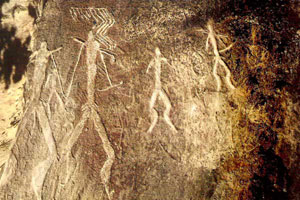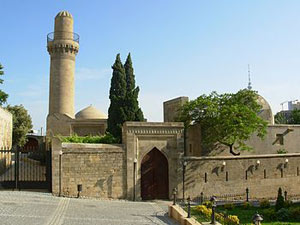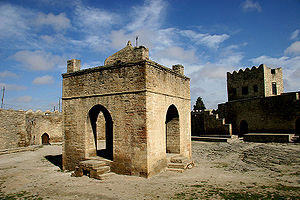Home page
» THE CAPITAL
» Baku
» Historical monuments of the capital
Historical monuments of the capitalBaku and its surroundings are known with rich with historical monuments not only in Azerbaijan but around the world. Among these, Gobustan, Shirvan Palace, Maiden Tower, Ateshgah, etc. are more popular.  It is district of low mountains and foothillsof the Great Caucasus located in west and south-west of the Absheron Peninsula, in 60 km away from Baku. Gobustan name was taken from Gobu word. Therefore, Gobustan is considered to be the land of the gorges and ravinesd. More than 6 ancient petroglyphs, which reflects the material and spiritual culture of ancestors of Azerbaijani people in the mountains of Gobustan. In addition, the ancient settlements - 20 caves and settlements, 40 burial mounds and more than 100 excavations of material culture were found. İt is considered that the ancient paintings related to the Mesozoic era, but it does not exclude the living here was even in BC. So, therefore, Gobustan is considered to be one of the cradles of the culture.  Palace of the Shirvanshahs Shirvanshahs palace ensemble is the largest branch of the Shirvan-Absheron architectural monument. In 1964 complex was declared as museum-reserve and taken under the state protection.  The most magnisifent and the largest strongholds of Absheron peninsula is, the Maiden\'s Tower in Old Town in Baku. Its height is 28 meters, diameter is 16-16,5 meters, wall thickness at the bottom side is 5 meters, and 4 meters in the upper side, and the Maiden\'s Tower consists of a cylindrical shape real castle and a large support base in the south side adjoined to it. What was the purpose of use of structure is still had hot been determined. The tower is divided into eight floors, and each floor had a separate stone ceiling or dome. These floors are connected with each other with stone stairs built inside of walls. On the facade of the castle there is a large stone over which the Kufic inscription was written. Words The Tower of David\'s son, Masud were written. The inscription allows saying that this fortresws was built in the first half of XII century by Seljuk soltan Masud. There are various legends about Maiden Tower among the the people. Of these, the most spread of them is a legend narrating about the tragic death of maiden, daughter of local ruler, that had thown self from the Tower; upper square.  Temple of fire- Ateshgah One of the most interesting and unique historical and architectural monuments near Baku is the old temple called by Indians Ateshgah. It is located a little far from the sea, in the village of Surakhani at the south-east end of Absheron peninsula. Cell and chapel were built at different times during the XVII-XIX centuries. at the end of the XVIII century cells were taken behind the fences. Ateshgah was built by migrants from Nothern India, majority of which were Sikhs, living in Baku. All of the building remembering caravansaray was in the form five corners and consisted of 24 cells and one room once used to provide services to pilgrims. Temple was preserved in the form as it was built.
|
